
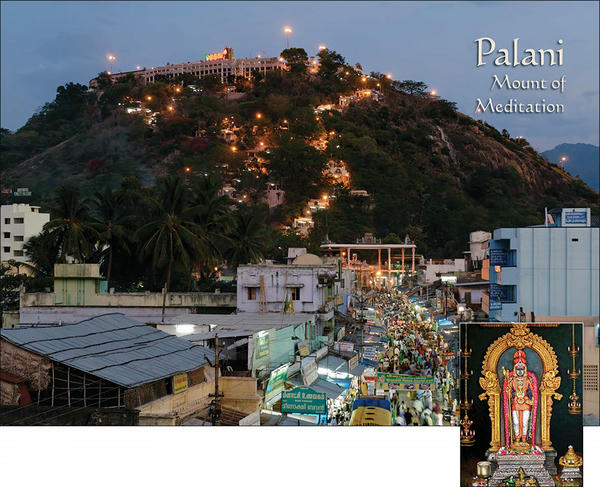
M. AMIRTHAM/DINODIA§
A. MANIVEL§
On the hilltop: As night falls, devotees proceed to Palani’s steps; (inset) a painting of the Dandayuthapaniswami murti in regal attire
• • • • • • • • • • •§
 HE MOST REVERED OF ALL TEMPLES TO LORD MURUGAN is the Arulmigu Sri Dandayuthapani Swami Tirukkoyil at Palani. This third abode is 137 km northwest from Madurai, and reached via Madurai by train, bus or car. The countryside here has a pre-historic feel to it—lone, worn hills that rise abruptly from the ground like rough-hewn tortoises. At any time of year, devotees are seen walking alongside the roads leading to Palani. Carrying only a small yellow bundle of necessities, they undertake this difficult trek, coming from all over South India. As we near Palani, the temple comes into focus at the top of the rounded hill, a verdant mountain range in its background. Accommodations are simple here, even austere. The temple devasthanam runs a huge hostelry near the temple steps, and there are private hotels and lodges in town.§
HE MOST REVERED OF ALL TEMPLES TO LORD MURUGAN is the Arulmigu Sri Dandayuthapani Swami Tirukkoyil at Palani. This third abode is 137 km northwest from Madurai, and reached via Madurai by train, bus or car. The countryside here has a pre-historic feel to it—lone, worn hills that rise abruptly from the ground like rough-hewn tortoises. At any time of year, devotees are seen walking alongside the roads leading to Palani. Carrying only a small yellow bundle of necessities, they undertake this difficult trek, coming from all over South India. As we near Palani, the temple comes into focus at the top of the rounded hill, a verdant mountain range in its background. Accommodations are simple here, even austere. The temple devasthanam runs a huge hostelry near the temple steps, and there are private hotels and lodges in town.§
We are excited to arrive at Palani. While Murugan in any form is dear to Saivite monks, here He appears as the loincloth-clad renunciate, called Dandayuthapaniswami. Palani means “You are the fruit,” an allusion to a tale in which Murugan learned that He is the fruit of wisdom of the sages.§
After settling in, we meet our guide, Mr. M. Muthumanickam, a member of the government endowment board that administrates the temple. He takes us by auto-rickshaw to the bottom of the hill, where a road circuits the hill. Muthumanickam informs us that circumambulation of the hill is best done in the early morning or at twilight. It is now late in the afternoon, and we are eager to get to the temple. So, we worship briefly at the Vinayagar shrine and ardently climb the 697 steep, stone steps that zig-zag their way to the top. On subsequent visits, we explore the other ways provided to ascend the hill—rope car, winch trolley and an alternate, less steep pathway built for the temple elephant which is also used by children and the elderly.§
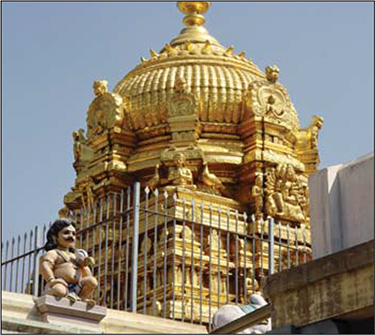
DAVE TROPF§
The gold-covered tower
• • • • • • • • • • •§
At the top, the steps give way to a wide, paved walkway surrounding the temple. Muthumanickam tells us, “It is traditional to go around three times.” This pradakshina gives pilgrims an opportunity to leave their journey behind and attune their minds to Lord Murugan before entering the temple. Wending our way through endless lines of devotees, passing through stainless steel gates and countless barriers, we arrive just outside the inner sanctum. We pay for special tickets to gain direct access to the shrine. Minutes later we are ushered in front of Lord Murugan for darshan.§
The unique murti here was created by Bhogar Rishi, one of the eighteen siddhars of Saiva tradition. He formed the image centuries ago from an amalgam of nine herbs and minerals. Abhishekam is the most important form of worship at Palani—the Deity is bathed six times a day. Muthumanickam relates, “These abundant ablutions over hundreds of years slowly deteriorated the murti. Sixty years ago the temple administration stopped all worship to the original murti and had a bronze replica installed directly in front of it for bathing.” In 2006, R. Selvanathan, Chief Executive Sthapati of Sri Vaithiyanatha Sthapati Associates, Chennai, was commissioned to perform the delicate and complex task of restoring the ancient image. Sthapati explains, “The murti was found to be infirm and unstable, presenting a frail appearance. Body parts were in a very dilapidated condition and may have broken up any moment if not attended to.” Selvanathan’s repair work was successful, and ablutions to the original murti resumed.§
In garments of bark these hoary seers are clad, their braided hair gleaming white like valampuri conch, their body so immaculately clean and fair, their high chest of bony ribs wrapped in deer skin, bodies lean with austere meals after days of fast; their minds unsullied and free from guile and hate; they are wise beyond the wisdom of the learned; they act as the goal and pivot of the knowers free from anger, greed and sufferings sore; with cheerful hearts and gracious mien they lead the way.§
TIRUMURUGARRUPADAI, LINES 126-127§
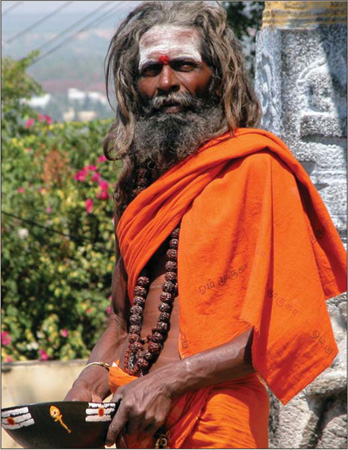
HINDUISM TODAY§
Jai Murugan: A resident sadhu begs alms
• • • • • • • • • • •§
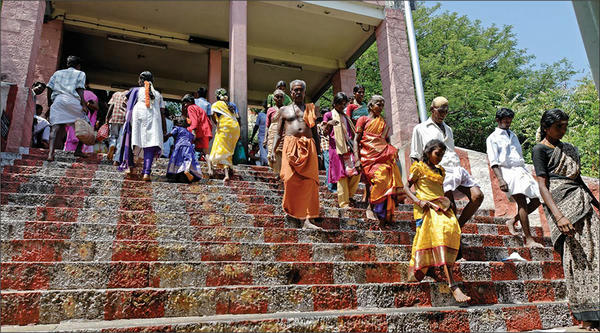
M. AMIRTHAM/DINODIA§
Devotees climb the 697 steps to and from the hilltop
• • • • • • • • • • •§
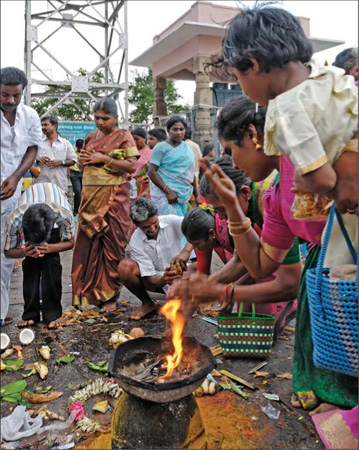
M. AMIRTHAM/DINODIA§
Pilgrims make offerings of camphor, coconuts and flower garlands
• • • • • • • • • • •§

M. AMIRTHAM/DINODIA§
Tiruvavinankudi, the nearby temple that is mystically connected to Palani
• • • • • • • • • • •§
Watching the puja is like watching an intricate dance. While only Adisaiva priests enter the inner sanctum, a clan of pandaram priests serves in the preparation of all offerings. Everything passes through their hands before being presented: abhishekam ingredients, clothing, garlands, food, incense and all the lamps. Every priest is dressed impeccably, his spotless veshti wrapped just right. Traditional Sanskrit Vedic mantras are chanted in the inner sanctum, but we hear a priest chant Murugan’s 108 names in Tamil over a PA system. We later see a sign near the shrine stating that, according to the requirements of the temple endowment board, archanas will be performed in Tamil upon request.§
While the Deity is being dressed, the crowd’s anticipation grows. Behind us hundreds are chanting, singing, praying. When the curtain finally opens, Murugan is adorned in raja alankaram, dressed like a king—so majestic, so magnetic. A cacophony of sounds envelopes us as the arati swoops past and priests smear vibhuti on the forehead of each one present.§
Inside the temple, we notice that a significant amount of renovation work has occurred since our 2004 visit. Particularly evident is the polished granite tile on the floors and walls inside and around the temple. The temple’s most recent kumbhabhishekam was on April 3, 2005. Former Joint Commissioner of the temple, Mr. D. Sundaram, reports, “The renovation work started on March 9, 2005, and finished on March 29. Amazingly, the task was performed by 1,000 workers per shift, three shifts per day. New mandapams in the first prakaram and all the granite floor and wall tile work was completed in just twenty days.”§
Muthumanickam informs us that Palani has the highest income of any temple in Tamil Nadu and is second in all of India only to Tirupati’s Venkateswara temple. That doesn’t count the enormous sums of money devotees spend in town on supplies—milk, yogurt, honey, ghee, vibhuti—which they bring to the temple in huge quantities for the daily abhishekams. He amplifies, “There is so much money, more than we can use here. We donate the rest to many of the poorer temples in Tamil Nadu—just enough to each one to keep the basic practices of lighting lamps and simple, daily puja going.” One of the ways in which Palani’s wealth manifests is in its cleaning program. There are workers collecting trash and sweeping and spraying down the walkways all through the day. They set a great example for other temples to follow.§
Sunset is nearing. Muthumanickam urges us to stay for the night-time golden chariot procession. We sit down to talk near the Ganesha shrine as the crowds gather. Nakkirar names the third padaiveedu, Avinankudi, and frequently it is said that this temple near the base of the hill is the true abode of Lord Murugan. We ask Muthumanickam about this, and he quickly dismisses the misconception: “The two are really to be considered one temple. They come under the same management and share the same priesthood. It is customary to visit there before coming up the hill to worship here.”§
By 7 pm nearly 100,000 people have amassed atop the hill. The devotion reaches a crescendo as the doors of the chariot shed are flung open. Accompanied by nadaswaram and tavil, the chariot begins to roll. This small, ornate carriage and the utsava murti that rides in it are solid gold. A company of police officers with guns and a set of wooden barriers surrounds the chariot from the moment the shed doors are opened until they are locked again. Devotees pay Rs 1,000 (us$25) for the privilege of going inside the barrier to more intimately worship the murti.§
The shrine to Bhogar Rishi in the southwest corridor provides a serene and quiet sanctuary in this bustling complex. Very much like a cave, it is a great place for quiet meditation. Introspective devotees can be seen here throughout the day, absorbed within themselves.§
The temple’s magic is potent, its vibration ever powerful. So many are captured by Palani. By what seems only to be grace they appear in front of the Deity. They watch an abhishekam and have an archana performed. An arati is passed. The priests put a garland from Murugan around pilgrims’ necks and smear vibhuti on their foreheads, and they go away transfixed. Even if they go to no other temple, their lives are transformed by the Lord of Palani in that single moment.§